Keeping freshwater shrimp, crabs and snails is an interesting part of aquarium keeping.
You may have a specialty shrimp tank with exotic species of Caridina. Some aquarists keep a single crayfish. Maybe you like to watch mystery or nerite snails glide across your aquarium.
The one thing all these freshwater invertebrates have in common is calcium. Calcium is essential for their health and growth.
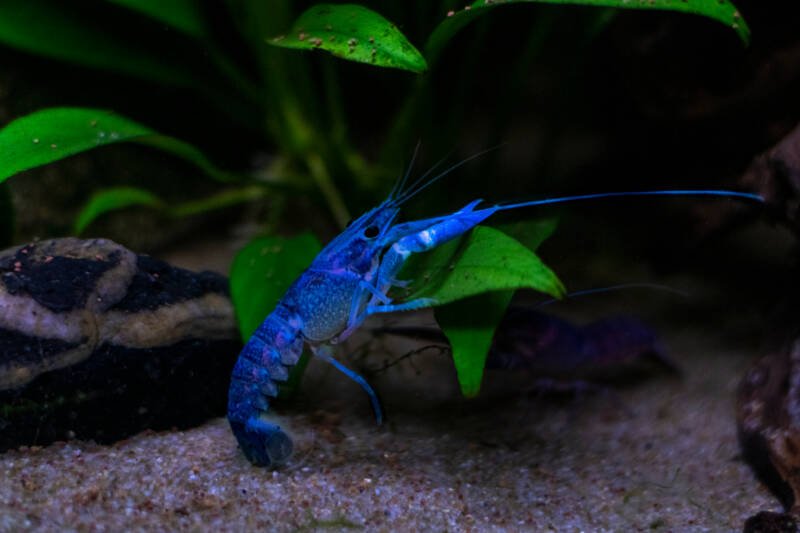
In this article
Why is calcium important?
Calcium (Ca++) is one of the most abundant elements on Earth. It is found in tap water and inside every living thing.
You probably know calcium is needed for strong bones. Our skeleton is made of calcium.
While shrimp, crabs, and snails don’t have bones, they do have a strong outer shell (exoskeleton) made of calcium carbonate. Snails build their protective shell by converting calcium into the beautiful, sturdy calcium carbonate shell.
Without adequate calcium, these invertebrates struggle to stay healthy and can even die.
Shrimp and calcium
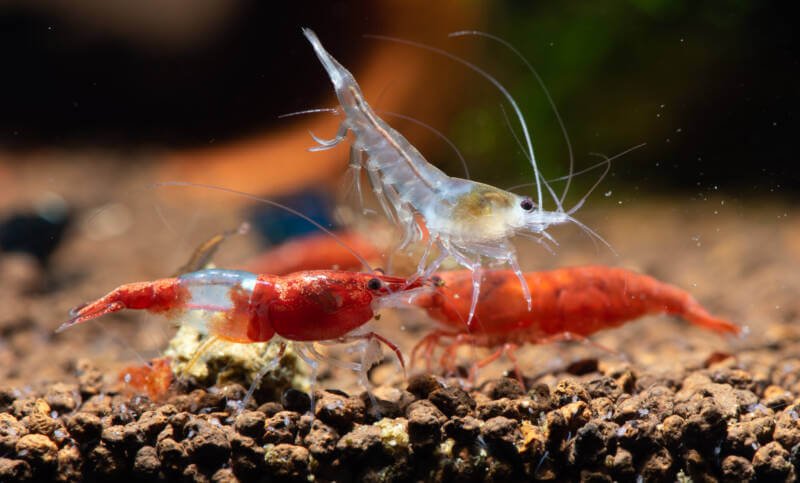
Calcium and chitin are the main components of freshwater shrimp and crayfish exoskeleton.
Chitin is an organic polymer that binds with calcium and strengthens the shrimp’s shell. The microfiber-like chitin blends with calcium to create a very strong armor plate that protects shrimp from predators.
The calcium-chitin combination is especially important for super-strong legs and claws.
Calcium and shrimp growth
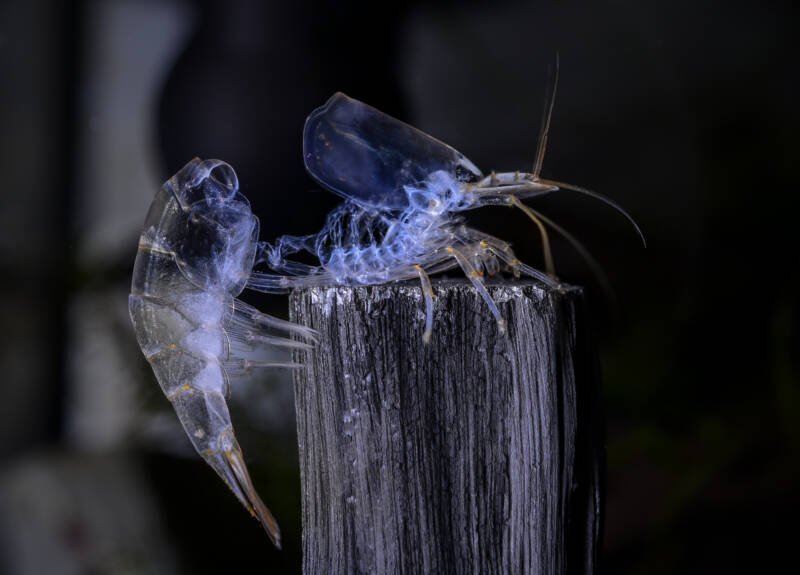
Freshwater shrimp grow by molting. They shed their old exoskeleton when it becomes too small.
During the molting process, shrimp lose calcium from their tissues. If you’ve kept Caridina shrimp, you may have seen the shrimp eating its old skeleton right after molting.
Shrimp reabsorb calcium from the old exoskeleton and use it to harden up their new “skin,” which is very soft right after molting.
Crabs and calcium
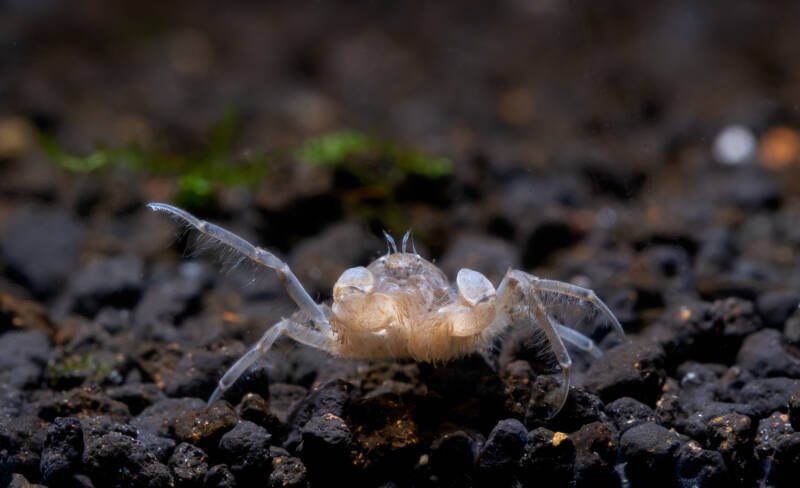
Freshwater and brackish crabs also use calcium and chitin to form their exoskeleton. Crabs take in calcium through gills and diet.
It’s converted into insoluble calcium carbonate, forming a tough “armor plate” that protects the crab and gives its clays and legs tremendous strength.
Freshwater snails and calcium
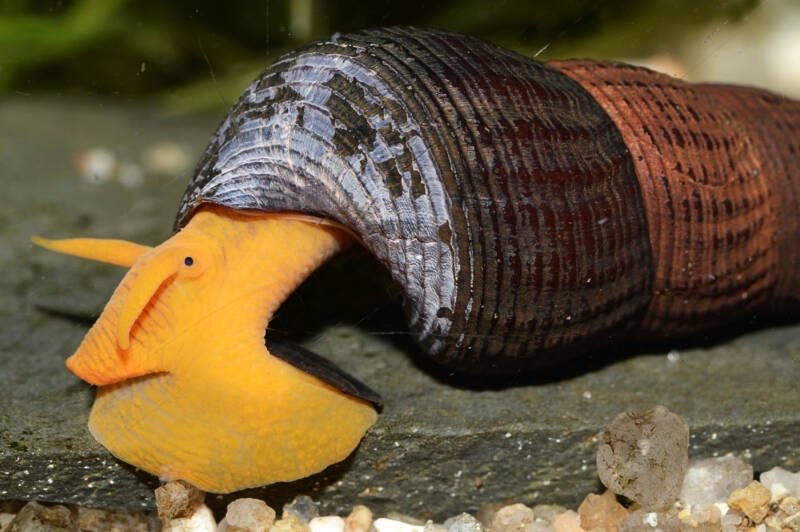
Almost 99% of a snail’s shell is made of calcium carbonate!
A steady supply of calcium carbonate is needed not only for shell-building but also for regulation of the snail’s internal pH.
Calcium also plays an important role in snail reproduction and egg formation.
Do fish need calcium?
Like all living animals, freshwater fish need calcium for bones, scales, teeth, and other biological functions.
Fish can absorb calcium from the water through their gills and their diet.
Where do freshwater invertebrates get their calcium?
Shrimp, crabs, and snails get their calcium from their diet and the water.
In the aquarium, calcium comes from tap water and the food added to the aquarium.
Calcium in food
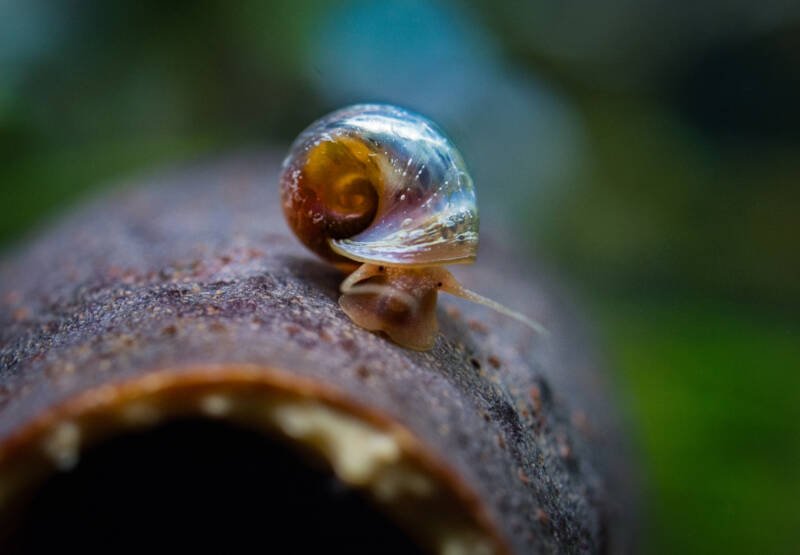
Prepared fish, crab, and shrimp foods are formulated with calcium-rich ingredients.
Feed regulations require commercial foods to contain a wide range of minerals in order to be considered a complete and balanced diet.
Fish and shrimp meal, a major protein source, includes bone meal. Bones contain calcium carbonate, which provides calcium to the formulation.
Calcium carbonate is digested by acids in the gut and used to make new shell material.
Ensuring your inverts have enough calcium
Research and aquarist experience has shown that a combination of a proper calcium-rich diet and adequate calcium level in the water keeps inverts healthy.
There are many types of prepared foods suitable for shrimp, crabs, and snails:
- Flake fish foods
- Sinking pellet food
- Shrimp pellets
- Algae wafers
- Crab pellets.
Shrimp Food Tip
An interesting shrimp feeding experiment showed that when shrimp are given large food pellets, they tend to become aggressive toward other shrimp in the aquarium.
For some reason, when they’re fed smaller pellets, the shrimp just chilled out and munched on their own tasty food pellet.
Smaller pellets should eliminate feeding aggression, especially in smaller shrimp tanks.
Natural foods contain calcium
As snails glide across the glass, driftwood, and plants, they continuously graze on live microbes living on the surfaces of the aquarium.
Crabs and shrimp forage and pick at algae and other debris in the tank.
Even though you can’t see it, they’re feasting on microscopic live foods like algae, bacteria, and plankton. These live foods are nutritious and are a source of calcium.
Calcium in tap water
Nearly all tap water supplies contain some level of calcium. Your water can come from a well, underground aquifer, or reservoir.
As groundwater slowly trickles through underground calcium carbonate deposits, the calcium will dissolve if the water is acidic.
Water high in dissolved calcium is considered “hard water.” Some water supplies contain very little calcium and are naturally “soft.”
Calcium in reverse osmosis water
RO water is great for freshwater aquariums – it gives you total control on how much minerals are in your tank.
That’s because the reverse osmosis process strips out calcium and other minerals.
You can blend unfiltered tap water into RO water, fine-tuning the final water chemistry. Just be aware that topping off with RO water adds no calcium to the aquarium.
Softened water
A home water softener removes calcium through ion exchange. As water flows through the softener, calcium ions are removed in exchange for sodium ions.
A water softener can remove some or all of the calcium in your water supply.
Calcium in the aquarium water
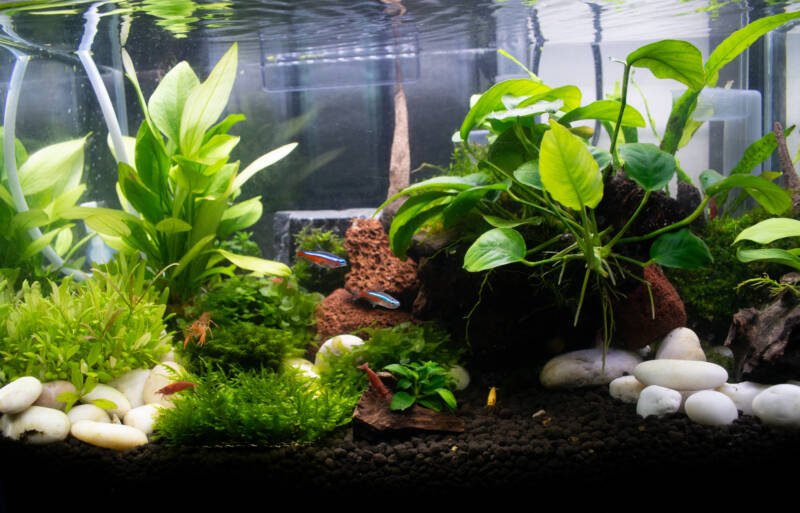
You’ll find a wide range of hobbyist opinions on what level of calcium is needed to keep shrimp, crabs, and snails in the aquarium.
Studies of the natural habitats of Caridina shrimp show that they thrive in water with only a few parts per million of calcium. This is an extremely low level of calcium, especially compared to the calcium levels in most tap water supplies.
Studies on snails indicate that a minimum calcium level of 25 ppm is beneficial for growth and shell thickness.
Research into optimal calcium levels for keeping freshwater crabs in captivity is almost non-existent but aquarist experience indicates they thrive in water with a calcium range of 30-100 ppm.
Measuring calcium levels
Calcium levels in aquarium water can be measured as calcium ions or a unit of measure called calcium carbonate equivalents.
- 10 ppm calcium is equal to 25 ppm “calcium as CaCO3”.
Both calcium levels are correct. They just use different units of measure.
Water hardness test kits measure the combined level of calcium and magnesium and give results in Total Hardness as ppm CaCO3.
Many water supplies contain almost no magnesium. This means most of the water hardness is based on the calcium level and can be used as a general indicator of calcium levels.
The Hanna Calcium Checker is an electronic device that displays the elemental calcium level on a digital display. It is designed for monitoring calcium levels in reef tanks.
The minimum elemental calcium level it detects is 200 ppm. That is equal to about 500 ppm total hardness.
The Salifert calcium test kit works by titration. You add the test chemical, drop by drop, to a vial of water until you see a color change.
Compare the amount of chemical added to a chart to determine the elemental calcium level in your water.
You can also keep an eye on the calcium level in your tank by monitoring the total hardness with a GH hardness kit.
As long as the water hardness is at least 100 ppm total hardness, your water will have enough calcium.
How often should I test?
In a freshwater aquarium, calcium and water hardness levels don’t change much over time.
Unlike a reef tank full of corals, a collection of shrimp, a few crabs, or snails are not going to quickly deplete the tank of calcium.
Monthly testing is all that is needed unless you’re making large water changes with calcium-free water.
How to increase calcium in the aquarium
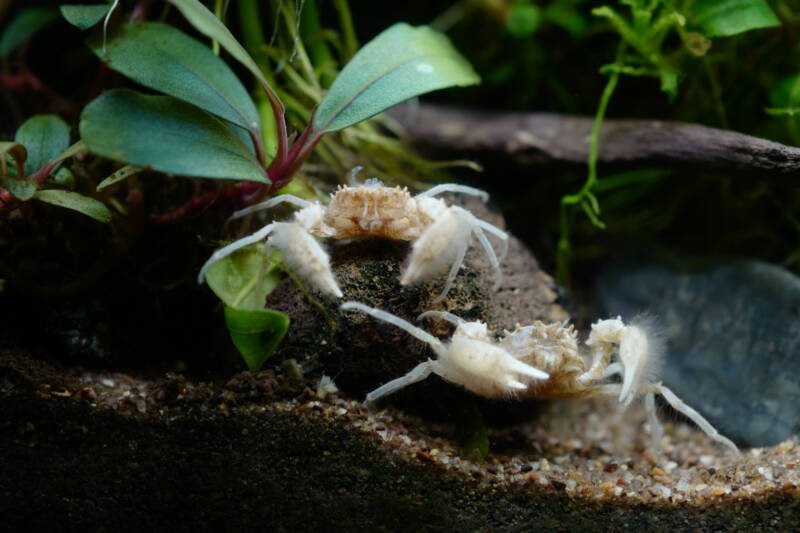
If you find your tank’s calcium level is too low, you can raise it by adding the right products.
You’ll find many calcium-increasing recommendations online, but not all are effective:
- Limestone gravel: Limestone or crushed coral gravel is primarily calcium carbonate. This form of calcium is insoluble at the pH range of aquariums. Unless the pH is very acidic, calcium carbonate won’t release calcium into the freshwater aquarium.
- Shells: Like coral, shells are made of calcium carbonate. They’re not a reliable source of calcium in a freshwater tank.
- Cuttlebone: This piece of cuttlefish bone is made of calcium carbonate. It is mostly insoluble in typical freshwater pH ranges.
- Eggshells: Eggshell is made of calcium carbonate.
If you want to raise the level of calcium there are several easy and effective ways to do it:
- Vacation fish feeding blocks: These calcium sulfate blocks are more soluble than calcium carbonate. Crabs, shrimp, and snails will feed on the food and get mouthfuls of calcium from the block. The calcium level in the water will also rise and be maintained by the slow-dissolving calcium sulfate.
- Wonder shell: This calcium sulfate block raises calcium and contains a chlorine neutralizer. It is similar to feeder blocks but contains no food.
- Slow-release turtle blocks: Made of calcium sulfate. Contains no food.
- Liquid reef calcium: Calcium chloride-based products are safe for freshwater tanks and won’t raise the pH.
Can I have too much calcium?
Calcium is not harmful to freshwater snails and crustaceans. But there is no benefit to raising the calcium level to abnormal levels.
It won’t make the animals grow faster, larger, or increase their coloration.
Can I use calcium additives formulated for reef aquariums?
Some calcium supplements will raise the alkalinity and boost the pH to saltwater levels.
However, this is probably not ideal if you want to maintain a freshwater tank with a pH range in the 6.5 to 7.5 range.
If the product is a single liquid containing calcium chloride, it is OK to use in your freshwater aquarium.
Do I need to add calcium when I top off for evaporation?
No. Reef aquarists dose their tanks heavily with calcium because the corals use it quickly.
Freshwater inverts only use a trace amount of calcium compared to corals. Use regular tap water for topping off.
Monitor the calcium or hardness level monthly and adjust as needed.
Is pH important?
Yes. If your aquarium creeps into the very acidic range, below 6.5, your inverts can become stressed.
Stress makes them more suspectable to diseases that attack freshwater invertebrates. Just because they’re “armor-plated” doesn’t mean they tolerate poor water quality.
Final recommendations
The first step in keeping Amano, cherry and other shrimp, freshwater crabs, and snails is to measure the calcium level.
The quick way is with a water hardness test kit. If you want to know the precise calcium level, the Salifert calcium kit provides the ability to test calcium in the lower ranges common to freshwater aquariums.
If your water supply is low in calcium, there are several options.
The calcium sulfate blocks will provide a gradual increase in calcium over time. Just drop a block in your tank, and the calcium level will rise over the next week.
Crabs and shrimp really enjoy picking at the food inside vacation feeding blocks, and it provides calcium in their diet.
Feeding your inverts with sinking pellets makes it easy to give them a complete diet fortified with calcium along with protein, vitamins, and minerals, but it won’t raise the calcium level in the water.
Liquid calcium products offer fast results and make it easy to mix up a batch of water when making water changes.
The label will tell you how much calcium each dose adds. Calculate how much you need to add to your tank or bucket of make-up water.
If you have questions or comments, leave them below!